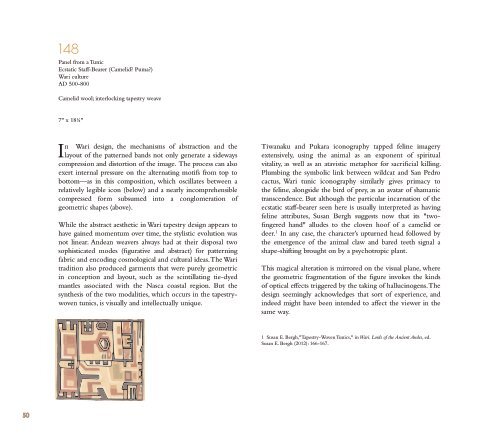You also want an ePaper? Increase the reach of your titles
YUMPU automatically turns print PDFs into web optimized ePapers that Google loves.
148<br />
Panel from a Tunic<br />
Ecstatic Staff-Bearer (Camelid? Puma?)<br />
Wari culture<br />
AD 500-800<br />
Camelid wool; interlocking tapestry weave<br />
7" x 18¼"<br />
In Wari design, <strong>the</strong> mechanisms of abstraction and <strong>the</strong><br />
layout of <strong>the</strong> patterned bands not only generate a sideways<br />
compression and distortion of <strong>the</strong> image. The process can also<br />
exert internal pressure on <strong>the</strong> alternating motifs from top to<br />
bottom—as in this composition, which oscillates between a<br />
relatively legible icon (below) and a nearly incomprehensible<br />
compressed form subsumed into a conglomeration of<br />
geometric shapes (above).<br />
While <strong>the</strong> abstract aes<strong>the</strong>tic in Wari tapestry design appears to<br />
have gained momentum over time, <strong>the</strong> stylistic evolution was<br />
not linear. Andean weavers always had at <strong>the</strong>ir disposal two<br />
sophisticated modes (figurative and abstract) for patterning<br />
fabric and encoding cosmological and cultural ideas. The Wari<br />
tradition also produced garments that were purely geometric<br />
in conception and layout, such as <strong>the</strong> scintillating tie-dyed<br />
mantles associated with <strong>the</strong> Nasca coastal region. But <strong>the</strong><br />
syn<strong>the</strong>sis of <strong>the</strong> two modalities, which occurs in <strong>the</strong> tapestrywoven<br />
tunics, is visually and intellectually unique.<br />
Tiwanaku and Pukara iconography tapped feline imagery<br />
extensively, using <strong>the</strong> animal as an exponent of spiritual<br />
vitality, as well as an atavistic metaphor for sacrificial killing.<br />
Plumbing <strong>the</strong> symbolic link between wildcat and San Pedro<br />
cactus, Wari tunic iconography similarly gives primacy to<br />
<strong>the</strong> feline, alongside <strong>the</strong> bird of prey, as an avatar of shamanic<br />
transcendence. But although <strong>the</strong> particular incarnation of <strong>the</strong><br />
ecstatic staff-bearer seen here is usually interpreted as having<br />
feline attributes, Susan Bergh suggests now that its "twofingered<br />
hand" alludes to <strong>the</strong> cloven hoof of a camelid or<br />
deer. 1 In any case, <strong>the</strong> character’s upturned head followed by<br />
<strong>the</strong> emergence of <strong>the</strong> animal claw and bared teeth signal a<br />
shape-shifting brought on by a psychotropic plant.<br />
This magical alteration is mirrored on <strong>the</strong> visual plane, where<br />
<strong>the</strong> geometric fragmentation of <strong>the</strong> figure invokes <strong>the</strong> kinds<br />
of optical effects triggered by <strong>the</strong> taking of hallucinogens. The<br />
design seemingly acknowledges that sort of experience, and<br />
indeed might have been intended to affect <strong>the</strong> viewer in <strong>the</strong><br />
same way.<br />
1 Susan E. Bergh,"Tapestry-Woven Tunics," in Wari. Lords of <strong>the</strong> <strong>Ancient</strong> <strong>Andes</strong>, ed.<br />
Susan E. Bergh (2012): 166-167.<br />
50







